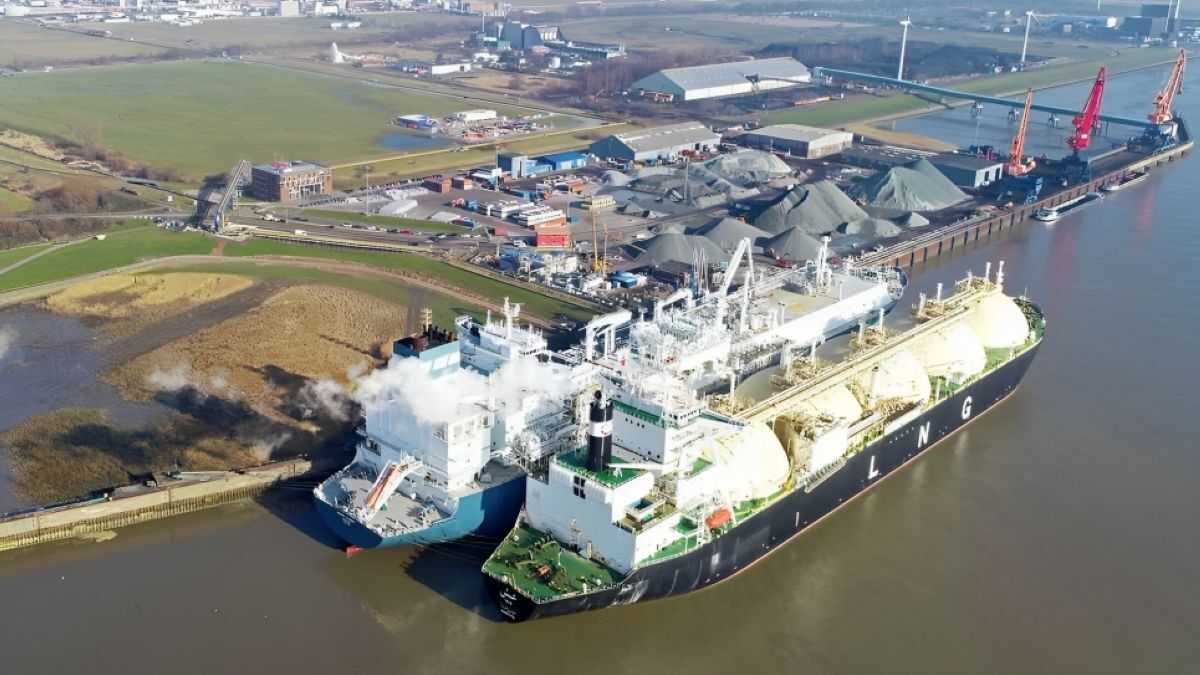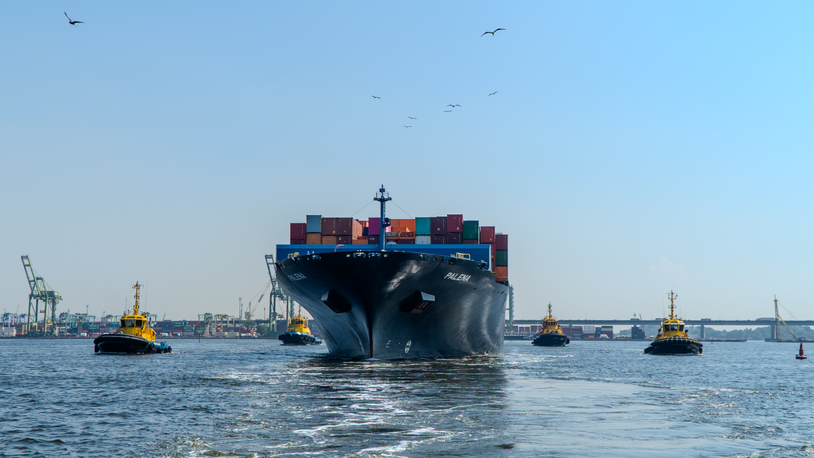Business Sectors
Events
Contents
Bigger is better for world’s largest container ship
Described by its owner China Shipping Container Lines Co (CSCL) as “the A380 of the shipping industry,” the sheer size of CSCL Globe has required journalists to employ a whole new range of terms in order to describe it. To the traditional measure of the number of football pitches it is in length (four), we can now add the number of tins of baked beans it could carry (900 million) and the number of Mount Everests that the combined height of all its containers would reach (13).
For once, however, such hyperbole is merited, as CSCL Globe is indisputably the world’s largest container ship – a title it has taken from the Maersk Triple-E. The vessel, which was completed and launched in late November 2014, was built by Hyundai Heavy Industries Co (HHI) in its shipyard in Ulsan, South Korea.
The container carrier is constructed according to the latest IMO standards for safety and environmental operations. The builders used the most modern technologies for fuel efficiency, navigation and cargo stowage, too. CSCL Globe has an overall length of 400m and a beam of 59m. The deadweight is 184,605 tonnes and the ship is 187,541gt.
Despite being almost the same size as the Maersk Triple-E class, CSCL Globe has higher capacity by over 700 teu, reaching 19,100 teu. The vessel is equipped with 2,000 reefer points for the transportation of temperature-controlled cargo, which improves its profitability and flexibility of operations. The cargo ship is not just the largest, but also one of the most advanced vessels for maritime transport.
The engineering of this giant is, as one would expect, also on a grand scale. The main propulsion for CSCL Globe comes from a low speed MAN B&W 12S90ME-C Mark 9.2 type engine. This is the biggest engine ever built, with a height of 17.2m. The state-of-the-art, two-stroke engine was built at HHI’s enginebuilding division and can generate 69,720kW of power at 84 rpm, but has been de-rated to 56,800kW.
Such power is enough for the vessel to reach service speed of 20.5 knots, while its maximum speed exceeds 22 knots. The efficiency of the ship is down to its modern engineering and its propulsion system, which reduce fuel consumption per teu by over 20 per cent compared with standard container carriers.
Compliance with the standards of IMO Tier II for CO2 and NOx emissions are achieved using the vessel’s exhaust gas recirculation (EGR) system. According to the company, this system results in the ship producing 30,000 tonnes less in CO2 emissions over a 12 month period than a conventional cargo ship. The vessel’s propulsion system is designed especially for ultra large container ships (ULCSs) with decreased energy loss and low revolutions. The improved propeller shape and attack angle of the blades increase the effective power and decrease the hydro-dynamic pressure.
The ship has been assigned DNV GL's Environmental Passport for Design (EP-D) class notation, which meets Marpol regulations as well as other environment-related IMO conventions. It complies with upcoming requirements for ballast water management, ship recycling, bilge water separation and recovery of refrigerants. The vessel features two EcoBallast sea water treatment systems, which can treat up to 3,000m³ of sea water an hour by filtering and sterilising bacteria and plankton larger than 50µm using ultraviolet rays.
As the ship was constructed to DNV GL class, the class society worked extensively on a feasibility study for CSCL Globe. Separately, it also analysed the structure and steel layout of the ship, including how many containers could be loaded on the hatch cover. CSCL Globe is a twin island design, which was first developed some years ago by DNV GL with various partners for 14,000 teu ships that were over 300m long.
Rather than the deckhouse being placed above the engineroom, it is separated and moved forward. This means that more cargo can be carried on the hatch cover while still complying with IMO regulations requiring the master to have unobstructed vision 500m forward. Jan-Olaf Probst, DNV GL director for business development and its specialist on container vessels, said: “In the arrangement we used for CSCL Globe, it is possible to store many more containers behind the deckhouse, as this does not obstruct the master’s view. If the yard had placed the deckhouse above the engineroom, then CSCL Globe would have lost capacity for as many as 900-950 containers.”
As well as providing greater cargo capacity, placing the deckhouse in this position means that the ship suffers less deformation – something that occurs due to waves from the side. This is a much greater problem for larger container ships of 400m long than those which are smaller. The thickness of the material used in the upper part of the vessel is up to 95mm – the upper limit of what steel manufacturing can produce at present for the maritime industry. The twin island design means that the containers are split into three sections, each with two supports rather than the one support that occurs in the traditional design.
Another benefit of moving the deckhouse is that there is space below it for the fuel oil tanks – for both heavy diesel oil and marine gas oil. The latter is used when the ship travels in emission control areas (ECAs). The fuel capacity is enough for one round trip of 24,000-26,000 nautical miles at a speed of 22 knots. “This gives CSCL the freedom to bunker in areas where fuel is the cheapest,” said Mr Probst.
More cargo can also be carried thanks to the lashing system that is used. Lashing bridges have been installed on deck, which means that containers can be lashed to a higher level. “More containers can be held, up to the hatch cover, as 11 containers can be stacked on top of each other. It means that they can be lashed more than 7.5m above the upper deck level. It also allows for more cargo as filled containers can be held at the top level, when often the top level containers include empties,” said Mr Probst.
Another factor that has helped CSCL Globe carry more boxes is the class notation it was given by DNV GL – Route Specific Container Stowage (RSCS). The vessel has been designed to operate under winter conditions in the North Atlantic, the most harsh weather environment, but the actual trade is Asia-Europe, where the sea conditions are much calmer than the transatlantic. These circumstances are taken into account, which means that the vessel can carry many more containers.
The vessel’s speed was an important consideration at the design stage. “We discussed maximum ship speed with CSCL quite extensively,” said Mr Probst. “The owner was really keen to ensure that the ship’s impact on the environment was as low as possible, so the yard designed for an optimum ship speed that was not too fast and not too slow. This means not only that fuel is saved, but also that there is less impact on the environment.”
The engine has been optimised to operate at a maximum of 22 knots in heavy weather conditions (and therefore faster in calm conditions) as well as over a wide speed range.“This allows it to operate efficiently. It also gives CSCL great flexibility, as it can run at an optimised load for the main engine – moving slower between two local ports but being able to run much faster if covering a wider geographical area,” commented Mr Probst.
The engine optimisation, whereby the fuel consumption is automatically controlled to reflect speed and weather conditions, means that the container ship will burn 20 per cent less fuel per teu compared with existing main engine models, DNV GL said.
CSCL Globe will be joined in 2015 by deliveries of four sisterships: CSCL Arctic Ocean, CSCL Atlantic Ocean, CSCL Indian Ocean, and CSCL Pacific Ocean. As well as holding the EP-D class notation, the CSCL vessels have cold ironing capabilities.
This ground-breaking ship is something that DNV GL is proud to have been a part of. Mr Probst commented that it has been very positive, not just for DNV GL but for European class societies in general. “The fact that a Chinese company chose a European class society is a sign of trust. We are very proud to see it docking near our maritime headquarters in Hamburg. It shows how much effort and knowledge the European maritime industry has put in, and it shows that Europe is still influencing this type of vessel.”
However, it seems that CSCL Globe may not retain its title of the world’s biggest container ship for very long. The 19,224 teu container vessel MSC Oscar is coming into service this year, a Japanese line is planning a 20,000 teu container ship and naval architects are reportedly looking at designs that could push container capacity as far as 24,000 teu. MP
Related to this Story
Events
Maritime Environmental Protection Webinar Week
Cyber & Vessel Security Webinar Week
The illusion of safety: what we're getting wrong about crews, tech, and fatigue
Responsible Ship Recycling Forum 2025
© 2024 Riviera Maritime Media Ltd.













